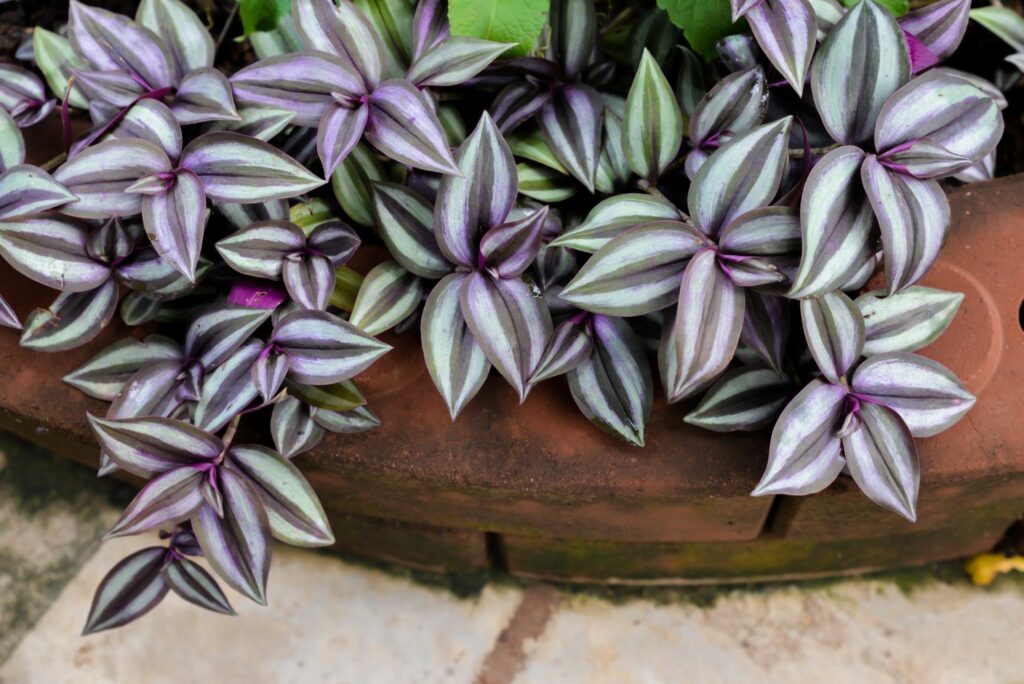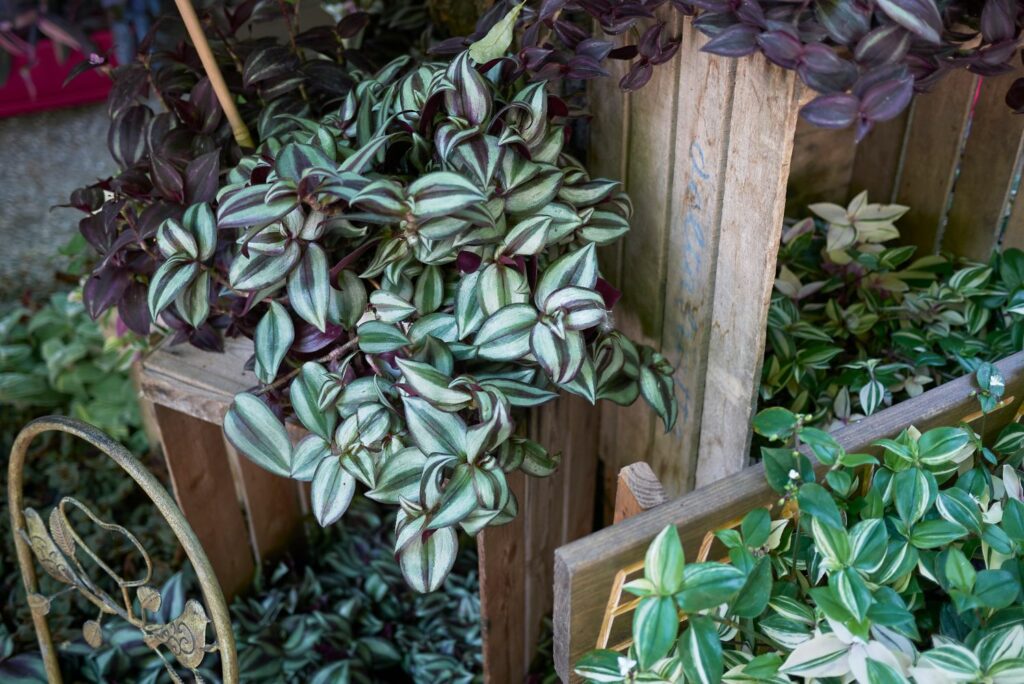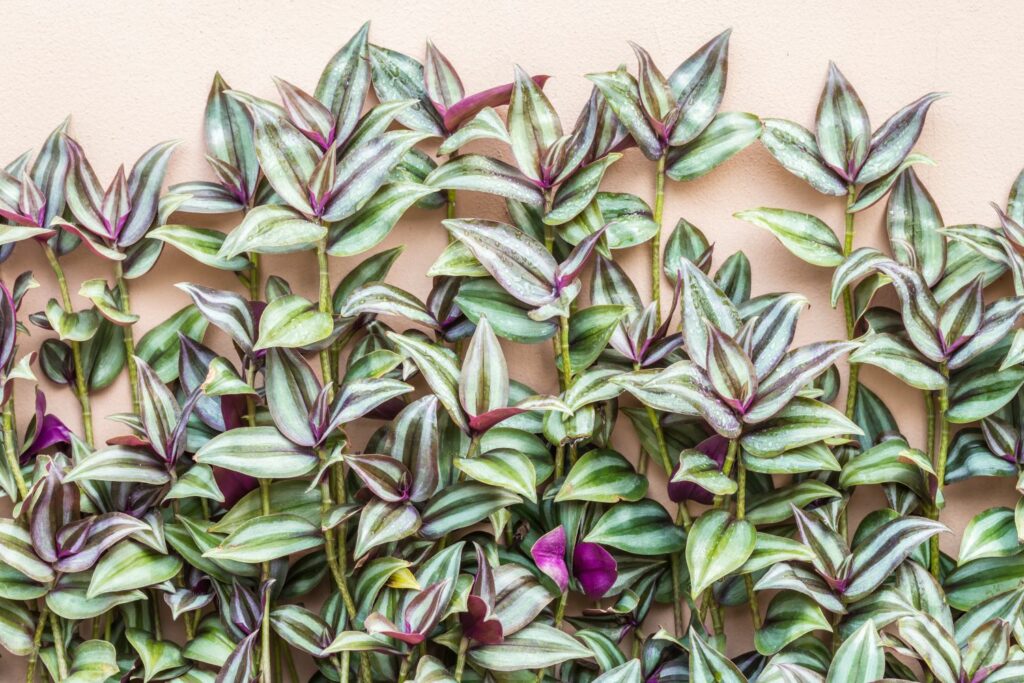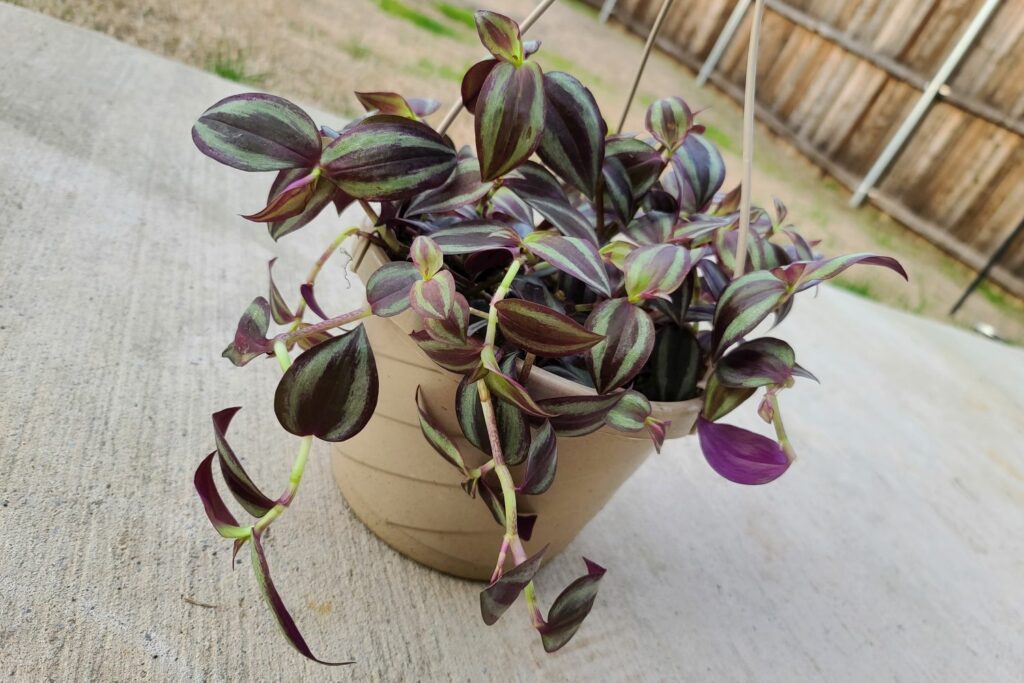Tradescantia zebrina: how to grow & care for the inch plant
Tradescantia zebrina stands out from all the other green houseplants with its colourful, zebra-patterned foliage. Here you will find the most important information about inch plant care and location.

The long shoots of the inch plant (Tradescantia zebrina) look best trailing from a hanging basket. In this article you will learn, among other things, how to help this popular houseplant to grow bushy and everything you need to know about its care.
Contents
Tradescantia zebrina: flower, origin, and characteristics
Native to Central and South America, Tradescantia zebrina belongs to the Commelinaceae family. There is some disagreement about what genus it belongs to: sometimes it is classified as a member of the spiderwort genus (Tradescantia), but sometimes it is considered a separate genus, Zebrina pendula. This spiderwort is also known as the violet inch plant or the wandering Jew plant. Alongside its decorative leaves, the inch plant in nature develops pink flowers all year round which are located individually in the leaf axils (the points on the plant where leaf stalks branch out from the main stem). Tradescantia can also flower as a houseplant, provided it gets enough light. As a succulent-stemmed plant, the inch plant can store a little water in its leaves and shoots.

The most beautiful varieties
As well as the classic inch plant, there are also several other varieties of Tradescantia zebrina that differ mainly in their colouring. Here is a brief look at the most beautiful Tradescantia varieties:
- Tradescantia zebrina ‘Quadricolor’ has pink rather than purple leaves, which make a beautiful pattern together with the green and white stripes.
- Tradescantia zebrina ‘Purpusii’ has particularly vivid purple leaves that stand out next to the other, mostly green houseplants.
- Tradescantia zebrina ‘Discolor’ also boasts leaves with different coloured stripes in pink, green, and silver.

Planting Tradescantia zebrina: when, where, and how
The Tradescantia zebrina plant is straightforward when it comes to care and location. Place the inch plant in a bright spot that is protected from the midday sun. However, a little sun in the evening or morning is beneficial. During the growth period, keep the plant at normal room temperature, so between 20 and 25°C. During this period, you can also keep Tradescantia zebrina outside on a balcony or in the garden. Here, again, place the plant in a sheltered location, without full sun. In winter you can keep the inch plant in slightly cooler temperatures, between 12 to 15°C is sufficient.
Tip: If Tradescantia zebrina gets enough light, with a bit of luck you will be able to enjoy its beautiful flowers.
The inch plant does not need any special soil; a versatile all-purpose potting soil is absolutely fine. A particularly sustainable choice is, for example, our Plantura Organic All Purpose Compost: Its clay minerals ensure the soil has a good water storage capacity, so that the plant has a continuous supply of water. Furthermore, the slightly acidic pH value is ideal for Tradescantia zebrina.

When using cuttings to plant Tradescantia zebrina, you can place several cuttings directly in one pot. Depending on the size of the pot, 10 to 15 cuttings will fit next to each other and make the inch plant look bushier.
Tip: A hanging basket is an excellent way to display the inch plant’s trailing shoots. Place the pot in a bright location, for example in front of an east-facing window.
Tradescantia zebrina care
It does not take a lot of care to grow a healthy inch plant. Like almost all tropical plants, it only needs water every so often and occasional applications of fertiliser. Regular pruning can also help shape the plant’s growth.

Watering, fertilising, and pruning Tradescantia zebrina
Water the inch plant regularly and make sure that the root ball is always moist. You may allow the soil to dry out on the surface every so often, but then water again. Lime-free water is best. Young plants need a little more water, so always keep their soil evenly moist. Avoid waterlogging by draining excess water from the pot a few minutes after watering.
During the growth phase, the inch plant needs fertiliser occasionally to ensure a good supply of essential nutrients. A classic green plant fertiliser works for this, such as our Plantura Liquid Houseplant Food. This encourages lush foliage and healthy growth so that Tradescantia zebrina can develop long shoots. The microorganisms in our fertiliser also stimulate root growth.

- Perfect for a wide variety of houseplants & foliage plants
- Liquid fertiliser for robust plants & healthy growth
- Quick & easy application - child & pet friendly
As the shoots of Tradescantia zebrina usually grow quick and long during the growing season, you may need to cut the plant back. On top of this, leaves on the ends of the shoots often dry out and are shed. Cut the shoots back generously in spring, to promote branching and bushier growth.
Tip: To help recreate tropical conditions, you can spray the inch plant with a water sprayer now and again.

Transplanting
You can repot the inch plant during the growing season, so between spring and autumn. If the old pot is completely rooted, it is time for a larger planter. Otherwise, transplanting every two to three years will suffice.
Propagating Tradescantia zebrina
The easiest way to propagate Tradescantia zebrina is from cuttings. In spring, simply cut a few shoots from the mother plant: These should already have some leaves. Then place the cuttings in a glass of water in a bright place. After a few days, roots should have formed, and you can plant the cuttings in a pot. As older shoots lose their leaves and become bare, we do not recommend using Tradescantia zebrina offshoots for propagation. The cutting method always produces new young shoots with plenty of leaves and shortens the bare shoots.

Overwintering: is Tradescantia zebrina hardy?
In winter, Tradescantia zebrina can tolerate cooler temperatures, but keep this above 10°C. Place the plant in a bright spot so that the leaves retain their vibrant colour. If the plant experiences freezing temperatures, shoots and stems may die of frost.
Is Tradescantia zebrina poisonous?
Inch plants are not poisonous to humans or animals, so you do not need to worry about placing it in your home.
There are many other spiderwort plants whose flowers also grow in our latitudes. Here you can find out everything about this beautiful plant genus.



















